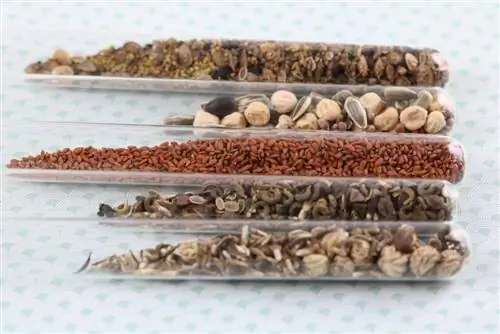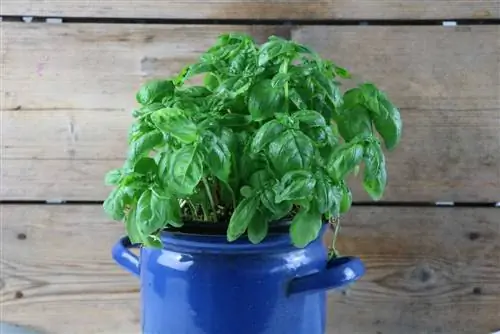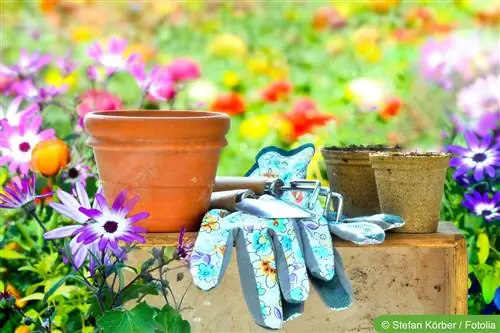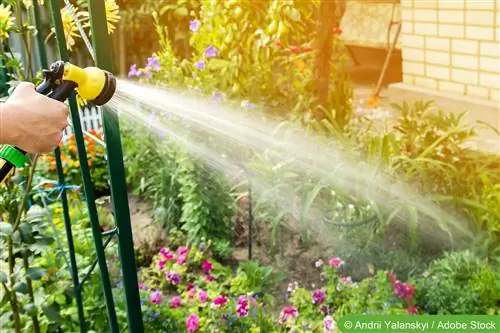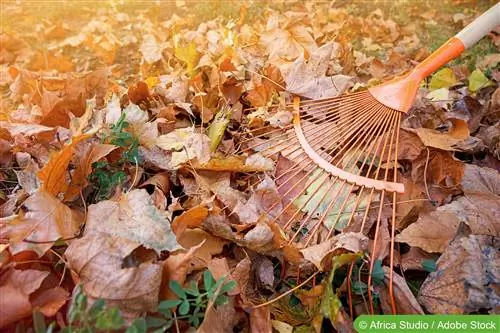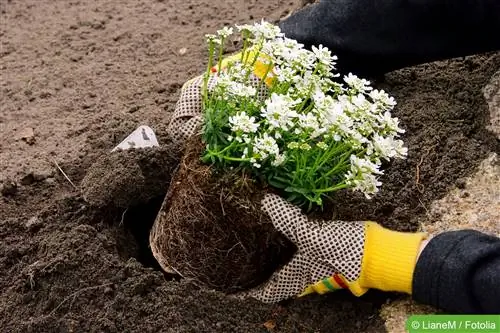- Author admin [email protected].
- Public 2023-12-17 03:39.
- Last modified 2025-10-04 22:41.
The best time to sow certain herbs can be found on many sowing calendars, with different times depending on the region's climate. That's why the soil temperature that a herb needs to germinate is taken into account here, which makes you independent of fixed times that only apply theoretically - for average weather in region X. Between the minimum and maximum tolerated germination temperature, this significantly extends the period for direct sowing in the garden. If you still want to prefer, start depending on the germination time listed below; You will also learn how to completely free yourself from time constraints when sowing seeds for/from indoor pot cultures.
Profile: sowing calendar and sowing times
- Sowing calendars indicate different sowing times for one and the same plant
- No wonder if one applies to a warm wine-growing climate and the next to cold areas in Lower Franconia
- The sowing time can be described more generally according to soil temperature
- Because, together with light and moisture, this initiates germination
- There is enough light in the garden, you can add moisture
- So the soil temperature is the determining criterion in the garden
- Like the air temperature, it can be requested from the weather service, URL follows below
- When growing herbs indoors, temperature and humidity can be influenced
- Here light is the limiting factor
- Today, cost-effective LED plant lights free you from any thought about sowing times
Sowing herbs in the pot
This is mainly about the following three scenarios:
1. Indoor herb cultivation under plant light
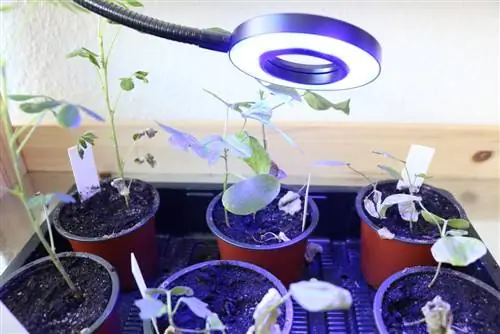
Since LED grow lights have made cost-effective lighting available for growing plants, you can grow herbs whenever you want. More and more people are doing exactly that; Especially people with an interest in he althy eating who live in rented apartments without a garden are increasingly discovering this type of herb cultivation.
You can do this as soon as you get an LED plant lamp. You don't need a sowing calendar for sowing, but rather a timer so that you don't have to remember to turn the plant lighting on and off yourself. The seedlings should be left in bright light for at least 8 and a maximum of 12 hours.
Tip:
Modern rod heaters can give new impetus to indoor plant cultivation in another direction: There are lots of spices that are obtained from plants that grow in a very warm environment. Chilis e.g. B. like warmth and thrive in the winter with enough light in the pot that hangs on the heater. The heater offers root temperatures of around 20 °C, tropical temperatures at which many plants thrive.
2. Herbs on the windowsill
If you want to work without plant light and other fuss, you should sow the herbs when they start growing in nature, so they thrive best. So in spring, you can find out the special preferences of the individual herbs in the sowing calendar below under 3.
But that doesn't mean that herb sowing is not possible at other times; later in early summer or summer, sowing can still be started without any problems. Large herbs and shrubs that grow slowly do not make it to their first harvest until winter. It doesn't matter, they can go into hibernation and then bring a rich harvest next spring.
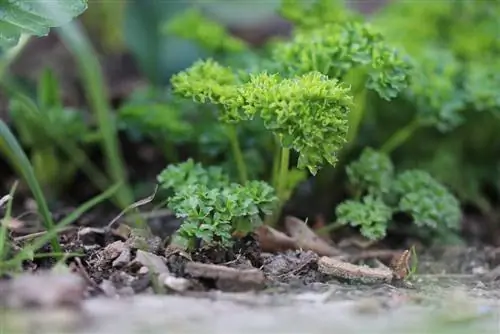
You can also sow some herbs in autumn, e.g. basil. B. feels very comfortable indoors. Cress is unbeatably robust and willing to grow and always grows, even in winter in poor light. Dill can also be grown all year round; Any other herb seeds you have left are definitely worth a try, a few edible stalks will usually come out.
Tip:
There aren't endless window sills available in the apartment, especially not particularly bright window sills. Above all, sow tender annuals that grow quickly and can be harvested. In this case, it is better to purchase long-lasting, shrub-like southern herbs, which fans of Italian, French and many other cuisines need in large quantities, from the nursery in advance and ready to harvest. Adult herbs also thrive on secondary light; You can even try revitalizing a low-light supermarket herb in fresh soil.
3. Prefer herbs in pots for the garden
The following sowing calendar applies to pre-breeding (with pre-breeding recommendations, average best pre-breeding start, sowing depth, germination temperature, germination time):
- Valerian: Pre-culture not recommended
- Wild garlic: no pre-growing indoors, needs frost to germinate
- Basil: Can be grown indoors all year round, can be moved into the garden in summer and brought back into the house in winter, light germinator (=seeding depth 0), germination temperature 20-22 °C, germinates in 15-18 days
- Savory, annual: Pre-cultivation from mid-March, light germinator, germination temperature 20-25 °C, germinates in 2-3 weeks
- Borage: Pre-cultivation from the beginning of March, sowing depth 2 cm, germination temperature 20-25 °C, germinates in 8-14 days
- Watercress: Pre-culture not recommended
- Dill: Can be grown indoors all year round, can be moved to the garden in summer and brought back indoors in winter, sowing depth 1 cm, germination temperature 18-24 °C, germinates in 2-3 weeks
- Tarragon: Pre-cultivation from mid-April, light germinator, germination temperature 18-25 °C, germinates in 7-14 days
- Garden cress see cress
- Chamomile: Pre-growing from the beginning of March, light germinator, germination temperature 16-25 °C, germinates in 15-20 days
- Chervil: Pre-breeding from the beginning of March, light germinator, germination temperature 18-25 °C, germinates in 10-14 days
- Coriander: Pre-cultivation from the beginning of April, sowing depth 1 cm, germination temperature 10-25 °C, germinates in 15-20 days
- Crow's foot plantain: The new trend salad herb cannot be preferred due to its growth habit
- Cress: No pre-cultivation necessary as it will be ready to harvest in a few days
- Caraway: Pre-cultivation from the beginning of March, light germinator, germination temperature 18-25 °C, germinates in 2-3 weeks
- Lavender: Pre-cultivation from mid-April, sowing depth 0.5 cm, germination temperature 20-25 °C, germinates in 21-28 days
- lovage: no pre-breeding indoors, should grow best when the seeds in the ground get frost
- Marjoram: Pre-growing from mid-April, light germinator, germination temperature 18-25 °C, germinates in 10-16 days
- Oregano: Pre-growing from mid-April, light germinator, germination temperature 18-25 °C, germinates in 8-16 days
- Parsley: Pre-cultivation from the beginning of March, sowing depth 1 cm, germination temperature 18-25 °C, germinates in 14-28 days
- Peppermint: Pre-growing from the beginning of March, light germinator, germination temperature 18-25 °C, germinates in 10-21 days
- Rosemary: Pre-cultivation from the beginning of April, sowing depth 1 cm, germination temperature 18-25 °C, germinates in approx. 28 days
- Salad arugula (rocket): Pre-culture in the house makes little sense
- Sage: Pre-cultivation from mid-April, sowing depth 0.2 cm, germination temperature 18-25 °C, germinates in 7-21 days
- Sorrel: Pre-breeding from the beginning of March, light germinator, germination temperature 16-23 °C, germinates in 7-21 days
- Cut garlic: Pre-cultivation from the beginning of March, sowing depth 2 cm, germination temperature 18-25 °C, germinates in 14-18 days
- Chives: Pre-cultivation from the beginning of April, sowing depth 2 cm, germination temperature 18-25 °C, germinates in 2-3 weeks
- Cut celery: Pre-culture not recommended
- Thyme: Pre-cultivation from the beginning of April, light germinator, germination temperature 16-22 °C, germinates in 10-18 days
- Woodruff: no pre-breeding indoors, needs frost to germinate
- Winter purslane: no pre-breeding indoors, should grow best when the seed gets frost in the ground
- Hyssop: Pre-breeding from mid-April, light germinator, germination temperature 8-25 °C, germinates in 7-21 days
- Lemongrass: Can be grown indoors all year round, can be moved into the garden in summer and brought back into the house in winter, sowing depth 1 cm, germination temperature 18-24 °C, germinates in 20-35 days
- Lemon balm: Pre-breeding from the beginning of April, light germinator, germination temperature 20-30 °C, germinates in 3-4 weeks
All of these herbs are raised until they are well developed and can be moved outdoors (=as soon as the soil outside has a temperature within the specified germination temperatures). In really rough areas, the herbs (as larger plants without cover) should rather grow up to the ice saints in the house. You can find out the current ground temperature from the German Weather Service at Werden.dwd.de/DE/leistung/bodentemperatur/bodentemperatur.html Select the federal state and weather station nearby.

The later the recommended sowing time, the more important it is usually that these heat-loving herbs get a sunny location in order to develop a nice aroma.
Sowing calendar for garden herbs
If you don't have to be stingy with every centimeter of garden space and can wait a little for the first herb harvest (e.g. because you can fall back on a nice supply from the previous year's harvest), choose relaxed direct sowing. The following sowing calendar applies to them, whereby the recommended planting distance is added here if necessary and the overall tolerated germination temperature is given instead of the optimal germination temperature (if the weather is not good but the seeds should be in the ground right now):
- Valerian: Direct sowing at soil temperatures of 6-25 °C, light germinator, germinates in 7-14 days
- Wild garlic: Direct sowing in autumn of the previous year, sowing depth 2-4 cm, germinates next spring
- Basil: Direct sowing at soil temperatures of 12-22 °C, light germinator, germinates in 15-18 days
- Savory, annual: Direct sowing at soil temperatures of 10-25 °C, light germinator, planting distance 25 cm, germinates in 2-3 weeks
- Borage: Direct sowing at soil temperatures of 8-25 °C, light germinator, germinates in 8-14 days
- Watercress: Direct sowing at soil temperatures of 6-15 °C, sowing depth 0.2 cm, planting distance 5 cm, germinates in 7-21 days
- Dill: Direct sowing at soil temperatures of 6-24 °C, sowing depth 1 cm, germinates in 2-3 weeks
- Tarragon: Direct sowing at soil temperatures of 12-25 °C, light germinator, germinates in 7-14 days
- Garden cress see cress
- Chamomile: Direct sowing at soil temperatures of 3-25 °C, light germinator, germinates in 15-20 days
- Chervil: Direct sowing at soil temperatures of 6-25 °C, light germinator, germinates in 10-14 days
- Coriander: Direct sowing at soil temperatures of 10-25 °C, sowing depth 1 cm, germinates in 15-20 days
- Crow's foot plantain: Direct sowing at soil temperatures of 12-25 °C, light germinator, germinates in 7-14 days
- Cress: Direct sowing at soil temperatures of 3-25 °C, light germinator, germinates in 2-4 days
- Caraway: Direct sowing at soil temperatures of 6-25 °C, light germinator, germinates in 2-3 weeks
- Lavender: Direct sowing at soil temperatures of 16-25 °C, sowing depth 0.5 cm, planting distance 30 cm, germinates in 21-28 days
- Lovage: Direct sowing at soil temperatures of 6-25 °C, sowing depth 3 cm, planting distance 60 cm, best sow in autumn of the previous year
- Marjoram: Direct sowing at soil temperatures of 12-25 °C, light germinator, planting distance 10-15 cm, germinates in 10-16 days
- Oregano: Direct sowing at soil temperatures of 12-25 °C, light germinator, planting distance 10-15 cm, germinates in 8-16 days
- Parsley: Direct sowing at soil temperatures of 3-25 °C, sowing depth 1 cm, germinates in 14-28 days
- Peppermint: Direct sowing at soil temperatures of 16-25 °C, light germinator, germinates in 10-21 days
- Rosemary: Direct sowing at soil temperatures of 3-25 °C, sowing depth 1 cm, germinates in approx. 28 days
- Salad rocket (rocket): Direct sowing at soil temperatures of 12-24 °C, sowing depth 0.5 cm, germinates in 10-14 days
- Sage: Direct sowing at soil temperatures of 12-25 °C, sowing depth 0.2 cm, planting distance 20 cm, germinates in 7-21 days
- Sorrel: Direct sowing at soil temperatures of 3-25 °C, light germinator, germinates in 7-21 days
- Cut garlic: Direct sowing at soil temperatures of 5-25 °C, sowing depth 2 cm, germinates in 14-18 days
- Chives: Direct sowing at soil temperatures of 5-25 °C, sowing depth 2 cm, planting distance 20 cm, germinates in 2-3 weeks
- Cut celery: Direct sowing at soil temperatures of 18-30 °C, light germinator, germinates in 14-21 days
- Thyme: Direct sowing at soil temperatures of 6-25 °C, light germinator, planting distance 20 cm, germinates in 10-18 days
- Woodruff: Direct sowing in autumn of the previous year, sowing depth 1 cm, germinates next spring
- Winter purslane: Direct sowing at soil temperatures of 2-12 °C, sowing depth 0.2 cm, best in the previous year
- Hyssop: Direct sowing at soil temperatures of 3-25 °C, light germinator, germinates in 7-21 days
- Lemongrass: Direct sowing at soil temperatures of 12-24 °C, sowing depth 1 cm, germinates in 20-35 days
- Lemon balm: Direct sowing at soil temperatures of 12-30 °C, light germinator, germinates in 3-4 weeks
You can see that although almost all herbs germinate best at temperatures of around 18, 20 °C, many of them can be sown much earlier, at soil temperatures of 3, 6, 8 °C. This fact explains the usually quite long period of time that is given as the germination time: If you sow one of the seeds that can tolerate this prematurely at 3 °C, it will sleep in the cold earth for a while until it germinates hesitantly, and then dies optimum temperature to really get started. Cold soil therefore extends the germination time; But if you know at what temperature a seed can actually go into the ground (without killing it or its ability to reproduce), it can take a lot of the stress out of gardening.
Tip:
If an herb needs soil temperatures of at least 12 °C to germinate, this suggests that this herb will not survive the winter here. However, this cannot necessarily be seen from the germination temperatures. Peppermint e.g. B. needs real warmth to germinate, but is uncritically frost hardy here, while rosemary germinates from 3 °C, but does not survive particularly cold winters outdoors. Frost hardiness must therefore be considered separately; Most southern herbs can only overwinter indoors (not every herb survives overwintering, but it's worth trying).

